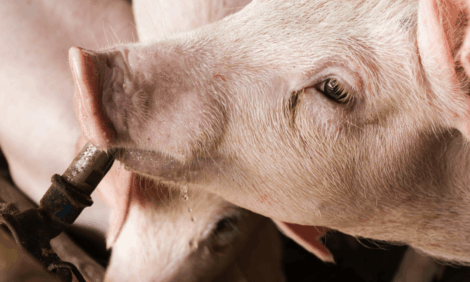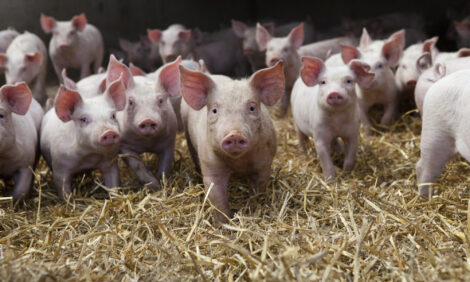



Foot and Mouth Disease: Novel Technologies Improve Detection and Control
Scientists at the USDA Agricultural Research Service are using infra-red technology to identify cattle infected with foot and mouth disease (FMD) virus. The same group has developed the world's first molecular-based FMD vaccine, which has been effective in pigs.Infra-red thermography (IRT) cameras can see what human eyes cannot: heat. That is why scientists at the ARS Plum Island Animal Disease Center (PIADC) at Orient Point, New York, are using the technology to identify cattle that may have been infected with foot-and-mouth disease (FMD).
"This IRT technology has been used for years and has applications for a variety of fields, from astronomy to law enforcement to the military," says PIADC research leader, Luis Rodriguez. "This is the first scientific report of IRT as a tool for early detection of FMD-infected animals."

The United States has not had an outbreak of FMD since 1929 but there is no way to guarantee that this very contagious disease is gone forever – as the United Kingdom learned in 2001, when an outbreak of FMD ended a 34-year disease-free streak. The disease spreads rapidly and wreaks havoc on trade and transportation, so being prepared for an outbreak is a priority for the US government.
An essential component of containment and eradication is the ability to quickly assess the scope of an outbreak.
"It's a huge endeavour to examine the animals one by one. Even on a small farm it's a big task," says Dr Rodriguez. He and his colleagues evaluated a new method for rapidly and accurately detecting animals at risk of infection. Their method, which uses IRT cameras to identify potentially infected animals quickly, is not intended to be a diagnostic test. Rather, it enables scientists to concentrate their resources by quickly isolating animals that require further testing with a disease-specific method.
IRT cameras can identify at-risk cattle 48 hours before they begin to show any clinical symptoms. In the event of an outbreak, this technology could facilitate rapid containment of the disease.
Spotting Hot Hooves


How does it work? Objects of all temperatures above absolute zero (about minus 460°F) emit infra-red radiation. The hotter the object, the higher the emissions, and IRT cameras make those emissions visible.
Foot temperatures rise in cattle infected with the FMD virus, resulting in a visible difference in IRT photographs. This phenomenon was observed by Craig Packer, a wildlife biologist at the University of Minnesota. While tracking migratory animal populations in Africa for an unrelated study, Dr Packer used an infra-red camera to take photographs of wild mammals and observed that some impala had very hot heads and feet. These animals, he learned, were suspected of carrying FMD. Curious about the implications, Dr Packer contacted the scientists at PIADC.
They followed up on Dr Packer's tip and conducted a formal study in PIADC's secure Biosafety Level 3 facility. Their results showed that IRT photography could detect elevated hoof temperatures up to two days before cattle developed clinical signs.
"By looking at the hottest spot in the hooves, we could identify FMD infected cattle when that temperature was higher than 34.4°C," Dr Rodriguez says. "It allowed us to predict with up to 88 percent confidence which animals would develop symptoms within 48 hours."
In an IRT photograph of a group of cattle, the hooves of healthy animals appear blue-green, whereas infected cattle have orange-red feet. This easy visual distinction could allow scientists and veterinarians to identify potentially infected cattle in large groups without examining animals individually. The technology is cheaper and faster than existing screening methods, which involve individual clinical examinations for every animal.
IRT can be paired with other ARS-developed tools for superior disease-outbreak response. One such tool is a rapid diagnostic test Plum Island scientists developed in response to a 2002 request from the US Congress.
The PIADC scientists collaborated with the biotechnology company Tetracore to develop the test, which can detect RNA from the FMD virus in less than two hours. It uses technology known as 'real-time PCR'. USDA's Animal and Plant Health Inspection Service has adopted the test and uses it in the National Animal Health Laboratory Network. In the event of an FMD emergency, laboratories throughout the United States could use the test to diagnose samples rapidly. It can also be used to quickly distinguish between FMD and vesicular stomatitis, an animal disease with similar symptoms that occasionally crops up in the United States.
A Safer, Better Vaccine
Another important FMD development from PIADC is the world's first effective molecular-based FMD vaccine for cattle, developed by chemist, Marvin Grubman, and colleagues. The vaccine can be produced without using infectious FMD materials, which means it can be produced safely, in the United States, without expensive, high-containment facilities.
Another benefit is that animals vaccinated with Dr Grubman's vaccine do not produce all the antibodies that infected animals produce. Because of this, they can easily be distinguished. Most existing vaccines cause animals to produce the same antibodies as infected animals, making it difficult to determine whether an animal with antibodies was naturally infected or vaccinated.

ARS – in collaboration with the US Department of Homeland Security's Targeted Advanced Development unit and GenVec, Inc., a biopharmaceutical company based in Gaithersburg, Maryland – is developing this technology for potential commercialisation.
Tests have shown that the vaccine becomes effective a mere seven days after it has been administered. Although this is one of the fastest vaccines available, Dr Grubman and his colleagues wanted faster protection. After all, a lot can happen in seven days, particularly during an outbreak. In a recent study, Dr Grubman found that interferons – proteins produced by the immune system – can offer protection during that first week.
Interferons are so named because they interfere with virus replication. Dr Grubman and his colleagues introduced type I and type II interferon genes into an adenovirus, which they administered to groups of pigs. One day later, they infected the swine with FMD virus. The interferons blocked FMD virus replication, offering the swine protection.
"The interferon gives early protection for three to five days while the animals are developing an antibody response to the vaccine," Dr Grubman says. "This significantly increases their chances of resisting FMD."
ARS and GenVec are now collaborating to combine the interferons and the FMD vaccine so they can be administered together.
April 2009








